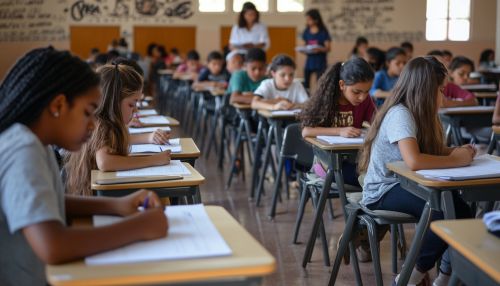Independent School Entrance Exam: Difference between revisions
No edit summary |
No edit summary |
||
| Line 23: | Line 23: | ||
The Upper Level ISEE is designed for students applying to grades 9 through 12. It mirrors the structure of the Middle Level exam but with more advanced content. The Verbal Reasoning section includes synonyms and sentence completions, while the Quantitative Reasoning section challenges students with higher-level mathematical concepts. | The Upper Level ISEE is designed for students applying to grades 9 through 12. It mirrors the structure of the Middle Level exam but with more advanced content. The Verbal Reasoning section includes synonyms and sentence completions, while the Quantitative Reasoning section challenges students with higher-level mathematical concepts. | ||
[[Image:Detail-104423.jpg|thumb|center|A diverse group of students taking a standardized test in a classroom setting, with desks arranged in rows and a teacher supervising.]] | [[Image:Detail-104423.jpg|thumb|center|A diverse group of students taking a standardized test in a classroom setting, with desks arranged in rows and a teacher supervising.|class=only_on_mobile]] | ||
[[Image:Detail-104424.jpg|thumb|center|A diverse group of students taking a standardized test in a classroom setting, with desks arranged in rows and a teacher supervising.|class=only_on_desktop]] | |||
== Scoring and Reporting == | == Scoring and Reporting == | ||
Latest revision as of 18:07, 18 November 2024
Introduction
The Independent School Entrance Exam (ISEE) is a standardized test used by many independent and private schools in the United States and internationally to assess the academic capabilities of applicants. The exam is designed to evaluate a student's readiness for academic challenges and is often a critical component of the admissions process for private middle and high schools. The ISEE is administered by the Educational Records Bureau (ERB) and is available in multiple levels to accommodate students from different grade levels.
Structure of the ISEE
The ISEE is divided into four levels: Primary Level, Lower Level, Middle Level, and Upper Level. Each level is tailored to assess students in specific grade ranges, ensuring that the content is age-appropriate and relevant to the educational stage of the examinee.
Primary Level
The Primary Level ISEE is designed for students entering grades 2 through 4. It consists of three sections: Auditory Comprehension, Reading, and Mathematics. The test aims to evaluate the foundational skills necessary for success in early education, focusing on basic reading comprehension, mathematical reasoning, and listening skills.
Lower Level
The Lower Level ISEE is intended for students applying to grades 5 and 6. It includes five sections: Verbal Reasoning, Quantitative Reasoning, Reading Comprehension, Mathematics Achievement, and an unscored Essay. The Verbal Reasoning section assesses vocabulary and reasoning skills, while the Quantitative Reasoning section evaluates mathematical thinking and problem-solving abilities.
Middle Level
The Middle Level ISEE is for students entering grades 7 and 8. It maintains the same five-section structure as the Lower Level but with increased complexity and depth. The Reading Comprehension section tests the ability to understand and analyze written passages, while the Mathematics Achievement section focuses on algebraic concepts and geometry.
Upper Level
The Upper Level ISEE is designed for students applying to grades 9 through 12. It mirrors the structure of the Middle Level exam but with more advanced content. The Verbal Reasoning section includes synonyms and sentence completions, while the Quantitative Reasoning section challenges students with higher-level mathematical concepts.


Scoring and Reporting
The ISEE is scored on a scaled system, with scores ranging from 760 to 940 for each section. The scaled scores are then converted into percentile ranks, which compare a student's performance to that of other test-takers in the same grade. The percentile ranks are a crucial component of the admissions process, as they provide schools with a benchmark for evaluating applicants.
The unscored Essay is sent directly to the schools to which the student is applying. While it does not contribute to the overall ISEE score, the Essay provides schools with insight into a student's writing abilities and critical thinking skills.
Test Preparation
Preparation for the ISEE often involves a combination of self-study, tutoring, and practice tests. Many students begin preparing several months in advance to familiarize themselves with the test format and question types. Practice tests are particularly beneficial, as they help students build test-taking stamina and identify areas for improvement.
Tutoring services are widely available and can offer personalized instruction tailored to a student's specific needs. Tutors often focus on reinforcing core academic skills, teaching test-taking strategies, and building confidence.
Test Administration
The ISEE is offered in both paper-and-pencil and online formats, providing flexibility for test-takers. It is administered at various test centers worldwide, as well as at some schools. The test is typically offered multiple times throughout the year, allowing students to choose a date that best fits their schedule.
Registration for the ISEE is conducted through the ERB's website, where students can select their preferred test date and location. Accommodations are available for students with documented disabilities, ensuring that all students have equal access to the exam.
Importance in Admissions
The ISEE is a significant factor in the admissions process for many independent schools. It provides a standardized measure of academic ability, allowing schools to compare applicants from diverse educational backgrounds. While the ISEE is an important component of the application, it is typically considered alongside other factors such as academic transcripts, teacher recommendations, and extracurricular involvement.
Criticisms and Controversies
Despite its widespread use, the ISEE has faced criticism and controversy. Some educators and parents argue that standardized testing places undue stress on young students and may not accurately reflect a student's potential. Additionally, there are concerns about the accessibility of test preparation resources, which can create disparities between students from different socioeconomic backgrounds.
In response to these criticisms, some schools have adopted a more holistic approach to admissions, placing less emphasis on standardized test scores and more on a student's overall profile.
